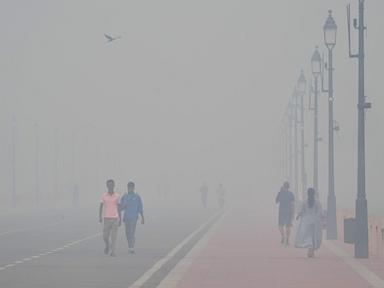World
New Delhi Chokes on Hazardous Air Quality After Diwali Celebrations

Thick smog enveloped New Delhi on November 14, 2023, following the widespread use of fireworks during the Hindu festival of Diwali. Millions of revelers celebrated late into the night, igniting firecrackers that significantly increased air pollution levels across the city. By Tuesday morning, the Air Quality Index (AQI) had surged above 350 in several neighborhoods, categorizing the air quality as “severe” and posing serious health risks, according to the World Health Organization’s guidelines.
Visibility dropped dramatically in various areas of the capital, with a gray haze obscuring streets, high-rises, and historical landmarks. “I have never seen anything like this before. We can’t see anything here because of pollution,” remarked Vedant Pachkande, a tourist visiting New Delhi.
Regulations and Enforcement Challenges
In a bid to address the pollution crisis, India’s Supreme Court had recently lifted a blanket ban on firecrackers for Diwali, permitting the use of “green firecrackers.” These alternative products, developed by federal research institutes, are designed to emit approximately 30% fewer pollutants. The court allowed their use during specified hours from November 11 to November 14, but enforcement proved challenging, as many residents ignored the restrictions.
New Delhi, along with its metropolitan area, is home to over 30 million people and consistently ranks among the world’s most polluted cities, especially during winter. This period coincides with both Diwali celebrations and agricultural burning in nearby states, which exacerbate the air quality crisis. Authorities have implemented measures such as limiting construction activities and restricting the operation of diesel generators to combat pollution levels.
Long-Term Solutions Needed
Despite these short-term interventions, environmentalists stress that sustainable solutions are crucial. They advocate for cleaner energy sources and stricter vehicle emission regulations to effectively mitigate the annual pollution crisis.
Recent studies highlight the broader implications of rising pollution levels, including a decrease in sunshine hours across India. Research published in Scientific Reports reveals that the amount of strong sunlight reaching the Earth has steadily declined due to increasing aerosols—tiny particles from industrial emissions, biomass burning, and vehicle pollution. “We see a greater impact in more polluted regions such as northern India,” stated Manoj K. Srivastava, a scientist at Banaras Hindu University and one of the study’s authors.
The reduction in sunlight could significantly impact India’s solar energy generation and agricultural productivity, in addition to affecting public health and the local environment.
As New Delhi grapples with the aftermath of Diwali celebrations, the urgent need for comprehensive strategies to address air pollution becomes increasingly clear. Without meaningful action, the city may continue to face hazardous air quality levels each year during festive periods.
-

 Science2 weeks ago
Science2 weeks agoIROS 2025 to Showcase Cutting-Edge Robotics Innovations in China
-

 Politics2 weeks ago
Politics2 weeks agoJudge Considers Dismissal of Chelsea Housing Case Citing AI Flaws
-

 World2 weeks ago
World2 weeks agoBravo Company Veterans Honored with Bronze Medals After 56 Years
-

 Lifestyle2 weeks ago
Lifestyle2 weeks agoStone Island’s Logo Worn by Extremists Sparks Brand Dilemma
-

 Health2 weeks ago
Health2 weeks agoStartup Liberate Bio Secures $31 Million for Next-Gen Therapies
-

 Top Stories2 weeks ago
Top Stories2 weeks agoIndonesia Suspends 27,000 Bank Accounts in Online Gambling Crackdown
-

 Sports2 weeks ago
Sports2 weeks agoMel Kiper Jr. Reveals Top 25 Prospects for 2026 NFL Draft
-

 Health2 weeks ago
Health2 weeks agoTop Hyaluronic Acid Serums for Radiant Skin in 2025
-

 World2 weeks ago
World2 weeks agoHoneywell Predicts Record Demand for Business Jets Over Next Decade
-

 Politics2 weeks ago
Politics2 weeks agoNew Jersey Voters Urged to Register Ahead of November Election
-

 Lifestyle2 weeks ago
Lifestyle2 weeks agoMary Morgan Jackson Crowned Little Miss National Peanut Festival 2025
-

 Sports2 weeks ago
Sports2 weeks agoYamamoto’s Mastery Leads Dodgers to 5-1 Victory in NLCS Game 2









